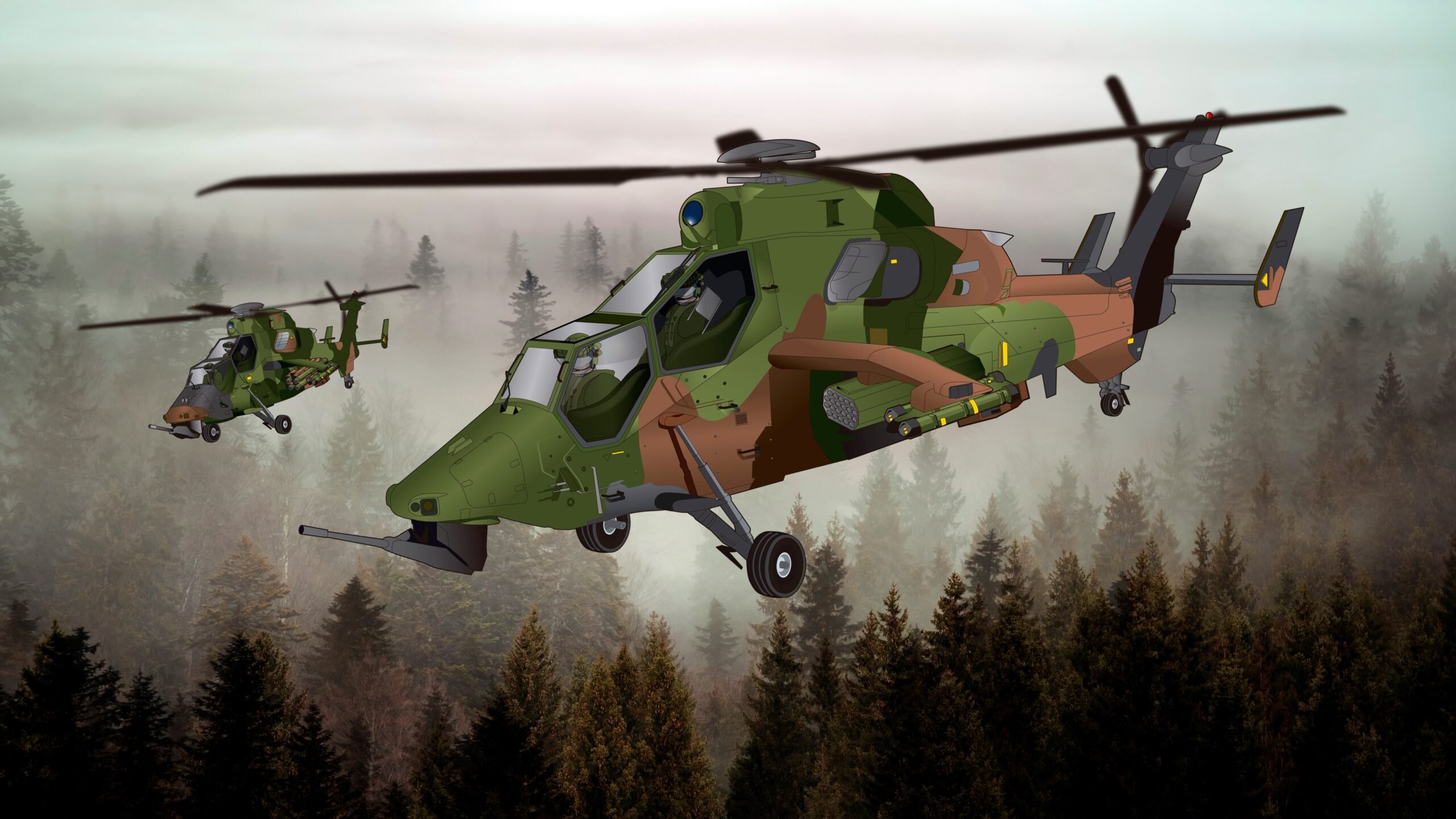
Concept art for the Tiger MKIII upgrade. (Airbus)
PARIS: The Tiger attack helicopters operated by France and Spain are set to receive a mid-life upgrade to improve their connectivity, precision, and fire power capabilities, at a cost of €65.8 million ($71.9 million) per aircraft.
The Tiger MkIII will be developed and produced by Airbus Helicopters, which was awarded a contract last week by OCCAR (Organisation Conjointe de Coopération en matière d’Armement), a joint organization that manages the Franco-Spanish-German Tiger program on behalf of those countries’ respective defense procurement agencies.
Discussions over the upgrade have been ongoing for months. France cannot afford to spend over $4 billion to modernize all 67 of its aircraft, so has opted to upgrade just 42 in a first tranche at a cost of €2.8 billion ($3.06 billion), with a 2029 delivery date. The remaining 25 might be upgraded later depending on whether Germany joins in after opting out of the initial upgrade decision.
That option looks more likely today than it did two weeks ago, following Chancellor Olaf Scholz’s announcement of a €100 billion ($109 billion) increase in his nation’s defense budget in the wake of Russia’s invasion of Ukraine. It’s now possible Germany may join the upgrade program later this year, which France believes would lead to enough cost savings across the program to cover the remaining platforms.
Spain, meanwhile, will spend €1.18 billion ($1.29 billion) to upgrade 18 of its 24 Tigers. These 18 MkIIIs will be delivered between 2030 and 2034. The remaining six, stored on the Colonel Sánchez Bilbao base in Ciudad Real (half-way between Madrid and Granada), are the original HAPs (helicoptère d’appui et protection) delivered to Spain in 2007 whilst awaiting the improved HAD version. Lack of money sidelined their scheduled upgrade to the HAD version. Instead, one of these aircraft will likely be used as the basis for the MKIII prototype scheduled for first flight in 2025, whilst the others will be used as a source of components.
There are currently four versions of the Tiger in use by four different nations. Australia has 22 ARHs (Armed Reconnaissance Helicopter); Germany has 57 UHTs (UnterstützungsHubschrauber Tiger), an anti-tank support version of the aircraft; France has 67 HADs (Helicoptère d’attaque et de destruction) and Spain has 24 Tigers of which 18 HADs and 6 retired HAPs (Helicoptère d’Appui Protection).
The French and Spanish versions will share many of the improvements, such as data links enabling the aircraft to directly receive images from drones, and the modernization of the self-protection system against anti-aircraft missile threats.
Both nations will also equip their Tigers with the Mistral 3 air-to-air missile. Safran’s inertial navigation system is a joint choice, as is the Strix NG optronic sight that includes several sensors in the visible and infrared bands equipped with image correlation and stabilization. The sight includes a new designation laser, illuminator and rangefinder. Thales will provide both nations with the TopOwl helmet-mounted sight display, GNSS, FlytX avionics suite and Contact/Synaps tactical radio station. Both will also get an Indra IFF upgrade.
However, some technologies will be specific to each nation, notably the battle management systems and some of the weapons.
The French Tigers will carry the MHT high tier air-to-surface missile, derived from the mid-range MMP missile in service with the French Army since 2017. This missile, with a range of over 8 km, is 20% lighter than other missiles in its category, providing weight savings of nearly 100 kg for the helicopter which it can then use to up its fuel capacity. MHT can handle a wide variety of targets, day or night, including in beyond-line-of-sight mode. The countermeasures will be provided by Thales, while the battlefield management system will be from ATOS. In addition the avionics will be overhauled so the Tiger can connect to the new Scorpion combat information system (SICS), gradually entering service in the French Army.
For Spain, new capabilities will include 70mm guided rockets and a new air to ground missile. Spain currently uses the Israeli-made Spike anti-tank missile on its Tigers. The battlefield management system and countermeasures will be supplied by Indra. In addition, Spain will add SATCOM functionalities and Link16.
Bruno Even, CEO of Airbus Helicopters, said in a statement that “the Tiger MkIII program will provide a European answer to the need for a state-of-the-art attack helicopter for the decades to come. With this upgrade, the Tiger will remain an essential and modern asset to its armies and reinforce defense cooperation in Europe.”
Airbus Helicopters will do final assembly at its Albacete, Spain, location. But work will also be performed at locations in Donauwörth, Germany and Marignane, France.
Australia tops up Ukraine military aid with $100M
Australia has already supplied Ukraine with 120 Bushmaster vehicles, six 155mm howitzers, 56 M113 armored vehicles, 14 special operations vehicles and its signature cardboard drones.


























